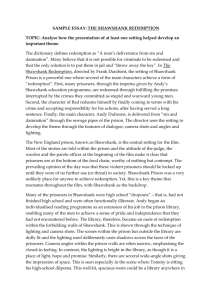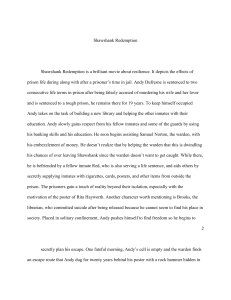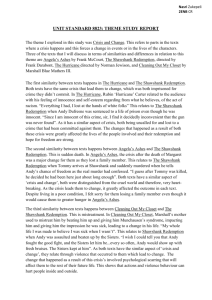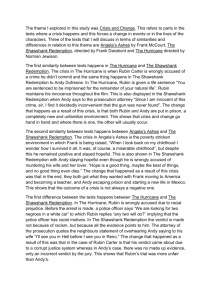Shawshank Redemption: Redemption Through Setting Analysis
advertisement
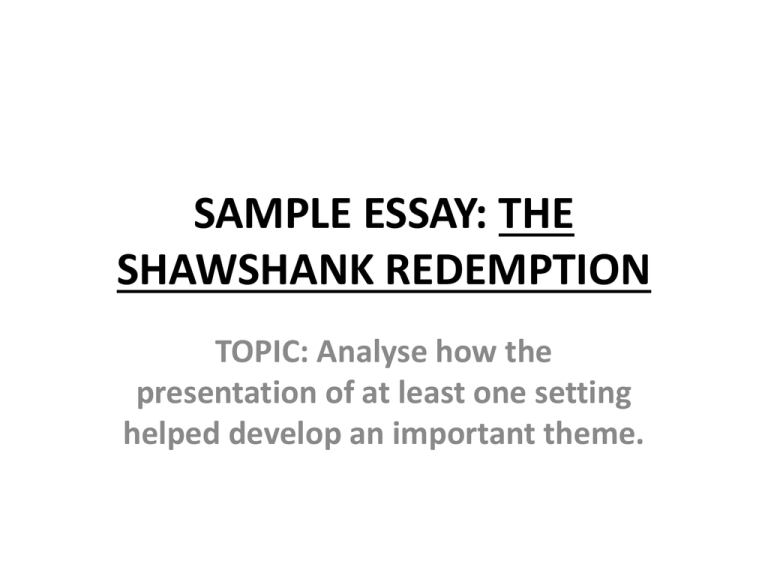
SAMPLE ESSAY: THE SHAWSHANK REDEMPTION TOPIC: Analyse how the presentation of at least one setting helped develop an important theme. • The dictionary defines redemption as “A man’s deliverance from sin and damnation”. Many believe that it is not possible for criminals to be redeemed and that the only solution is to put them in jail and “throw away the key”. In The Shawshank Redemption, directed by Frank Darabont, the setting of Shawshank Prison is a powerful one where several of the main characters achieve a form of “redemption”. First, many prisoners, through the impetus given by Andy’s Shawshank education programme, are redeemed through fulfilling the promises interrupted by the crimes they committed as stupid and wayward young men. Second, the character of Red redeems himself by finally coming to terms with his crime and accepting responsibility for his actions, after having served a long sentence. Finally, the main character, Andy Dufresne, is delivered from “sin and damnation” through the sewage pipes of the prison. • The New England prison, known as Shawshank, is the central setting for the film. Most of the stories are told within the prison and the attitude of the judge, the warden and the parole officer at the beginning of the film make it clear that prisoners are at the bottom of the food chain, worthy of nothing but contempt. The prevailing opinion of the day was that these violent prisoners should be locked up until they were of no further use (or threat) to society. Shawshank Prison was a very unlikely place for anyone to achieve redemption. Yet, this is a key theme that resonates throughout the film, with Shawshank as the backdrop. • Many of the prisoners in Shawshank were high school “dropouts” – that is, had not finished high school and were often functionally illiterate. Andy began an individualised reading programme as an extension of his job in the prison library, enabling many of the incarcerated men to achieve a sense of pride and independence that they had not encountered before. Some of the men even receive their high school diplomas, a feat many of them may have felt was impossible prior to their time in Shawshank. Prisoners, caged together and with time on their hands, often find that they have more determination to succeed with education while doing their “time”. • Red is an important man in the prison – that man who “can get you things”. Early in the film we witness a parole hearing where Red insists he has been rehabilitated. The Parole Board evidently feels that his words are false and, ten years later, when we see Red again rejected for parole, it seems as though he will never find public redemption. He is a man without hope, who has come to “depend on the walls” of the prison. However, through his long association with Andy and following Andy’s escape, Red finds the courage and inspiration to speak the truth at his third hearing in the prison and is granted parole. He accepts responsibility for his crimes and wishes he could speak to the “stupid kid” he was. He has gradually come to see Shawshank as a temporary stop on his life path, rather than the end of the road, and feels that he has paid enough of a price for his crimes. • Andy, the hero of the film, is the character who ultimately rejects the prison and everything it stands for, despite helping to make it a better place for the inmates at every opportunity. His symbolic rebirth at the end of the film, where he crawls through a sewage pipe and comes out “clean on the other side”, represents the ultimate redemption – that of the Christian promise of forgiveness, death and resurrection. The prison in Andy’s case was the beast to be tamed and conquered on his own journey towards redemption and his success in this both awes and inspires the remaining inmates for years to come. • Shawshank Prison is a foreboding place of little hope, yet many characters in the film find a form of redemption within its walls. The prisoners who gain success though the education programme have a higher chance of fitting back into society upon their release. Red grows to accept that the prison is a place to pay his debt to society and then to move on. Andy, the catalyst for the redemption found by the other characters, fittingly experiences redemption of the highest kind – escape from oppression and happiness in his new life.

